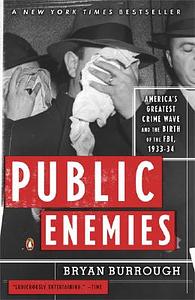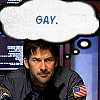Take a photo of a barcode or cover
80 reviews for:
Public Enemies: America's Greatest Crime Wave and the Birth of the Fbi, 1933-34
Bryan Burrough
80 reviews for:
Public Enemies: America's Greatest Crime Wave and the Birth of the Fbi, 1933-34
Bryan Burrough
This is a gripping and fascinating look at the lives of the last romantic desperadoes of American history and cultural mythology. Bryan Burrough does a fine job of bringing much of the era of outlaws and G-Men alive with keen research and a good narrative focus. In fact, Burrough strikes a perfect balance between scrupulous scholarship and fast-paced storytelling, leaving both history buffs and true crime readers something to enjoy. The best part about this book to me though is that Burrough is able to write about Dillinger, "Baby Face" Nelson, and others as well as their FBI pursuers without glorifying them. In this book, the criminals are seen for exactly what they are: criminals, and deadly ones too. And the FBI is portrayed as incredibly incompetent up until the death of John Dillinger. After that, the FBI becomes the premier police force that Hoover dreamed of, as Burrough points out. The worst part about this book is that Burrough never fully explains the appeal the outlaws had in mainstream society. Dillinger and others were famous "Robin Hood" figures in the public imagination, but Burrough only gives the lame explanation of it being the Depression and all that. No doubt that was the biggest contributing factor, but it's not a good enough explanation in my mind. Also, Burrough only mentions some of the extra-legal tactics of the FBI that would come to mark the Bureau under Hoover's reign. In fact, he only describes in detail some of these tactics, like kidnapping a suspect's wife and beating another suspect. But he never goes into greater depth about other events like this. Surely, for a police force that would become notorious for these actions, their origins should have been given a little more air time. In short, this is a great book to look too when looking for the true stories of Dillinger, Bonnie & Clyde, and others who are portrayed in movies, especially the recent Johnny Depp/Michael Mann movie based on this book.
This was interesting. And long. Burrough did some serious research and it shows. I can appreciate that. About 3/4 of the way through, though, I hit a wall and just wanted it to be over. However, the nonfiction story followed the lives of the major "enemies" of the 30s - Dillinger, Pretty Boy Floyd, Baby Face Nelson, Bonnie and Clyde, and the Barkers (among others).
There’s some interesting info here, but it’s mostly just a rundown of government ineptitude.
In an afterword to his novel G-Man, Stephen Hunter praised this work as "masterful." I've liked most of the novels by Hunter that I've read, so I took this as high praise indeed. Burrough's book is topical history at its best, I think. It tracks contemporaneously the exploits of the major crime figures of the Depression and how the FBI became a national police force in its, often haphazard, efforts to contain them. It is riveting, exceedingly engaging. Before the Hunter tip, I'd no especial interest in this subject, though I have enjoyed movies about the criminals of whom Burrough writes. (What license movies take!) This is the real deal factually. This is one of those books which, also, makes me appreciate what an author can achieve; there is merit in the execution and it elicited a full measure of respect from me.
[a:Bryan Burrough|32587|Bryan Burrough|https://images.gr-assets.com/authors/1217285796p2/32587.jpg] started the research on this book when he realized that Dillinger, Bonnie and Clyde, the Ma Barker Gang and other high profile kidnappers and bank robbers operated at the same time—1933-34. And they were being tracked down by the newly emerging FBI under J. Edgar Hoover. The FBI files were being made public and Burroughs was able to track down unpublished manuscripts from some of the participants and he also relied on the research of other authors who had interviewed survivors.
This is a very detailed story of the movements and crimes of the “public enemies” and the FBI team following them. It is told mostly chronologically. There are so many people involved that it is often difficult to follow who they are.
But Burroughs describes the main events so well that I found myself tearing through sections as if this was a crime novel where I didn’t know the outcome.
This is a very detailed story of the movements and crimes of the “public enemies” and the FBI team following them. It is told mostly chronologically. There are so many people involved that it is often difficult to follow who they are.
But Burroughs describes the main events so well that I found myself tearing through sections as if this was a crime novel where I didn’t know the outcome.
I have to admit, I picked this up because it had Johnny Depp on the cover. But nonetheless, it is really good. It's very factual and well researched; he gives footnotes, end notes, and has a bibliographic essay. But most of all, if he's not sure of something he tells you, or if two people have differing stories he tells you that. You feel like you're really getting as much of the true story as anyone can know at this point. Which is why the movie Public Enemies was such a disappointment. It's totally Hollywood-ized; the timeline is all wrong, events are made up, events are just represented entirely incorrectly. Oh well. It was still entertaining.
I would put this up against [b:Devil in the White City|21996|The Devil in the White City Murder, Magic, and Madness at the Fair that Changed America|Erik Larson|http://photo.goodreads.com/books/1167325045s/21996.jpg|3486041] as one of the most compelling nonfiction books I've ever read. I missed a train stop reading it, which is about the highest compliment I could give. :) It's obviously well-researched, and not just the events but the environment is rendered beautifully. But more importantly, the author clearly had the time of his life writing this book, and it shines through.
Now I REALLY can't wait to see the movie, although it'll be hard to not pay attention to all the changes I'm sure they had to make.
Now I REALLY can't wait to see the movie, although it'll be hard to not pay attention to all the changes I'm sure they had to make.
Subject matter was extremely interesting but I hated how everything was presented. It was told in chronological order and with that many names, it was somewhat hard to keep straight. Wish he had focused on each gang separately even if they were interwoven at times
dark
informative
medium-paced
Very thoroughly researched and compiled. Eager to clear urban myths that have been over-blown since then.




